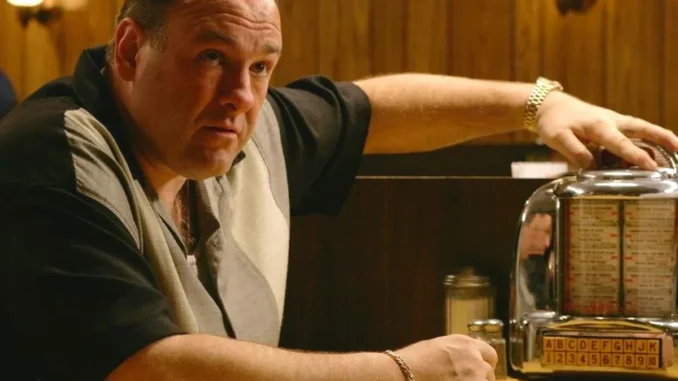
Even after 17 years, The Sopranos continues to spark heated debates about Tony Soprano’s fate. The series, hailed as one of the greatest television dramas of all time, ended on a note of ambiguity that left fans wondering: what really happened to Tony? From a diner full of suspicious characters to unresolved plot lines, let’s dive into the theories that attempt to explain how the iconic mob boss met his end.
1. The Guy in the Members Only Jacket
One of the most popular theories revolves around the mysterious diner patron in the “Members Only” jacket. This character has become a focal point for fans speculating about Tony’s demise. Why did the writers give him so much screen time? The prevailing thought is that he is there to exact revenge for Eugene Pontecorvo’s tragic fate, which Tony played a role in. Eugene, a character who wanted to retire peacefully in Florida, ended up taking his own life after being denied that chance. The theory posits that this nervous-looking guy in the diner is seeking justice—or revenge—on Tony for Eugene’s death.
2. A Homage to The Godfather
Another compelling theory suggests that the scene is a nod to an iconic moment in The Godfather. The diner scene parallels the moment when Michael Corleone retrieves a hidden gun to take out rival mobsters. As the guy in the “Members Only” jacket heads to the men’s room just moments before the screen cuts to black, many viewers believe he’s preparing for a similar hit on Tony. It’s a chilling homage that adds layers to the already tense atmosphere of the finale.
3. Paulie Walnuts’ Betrayal
Could Tony’s death have come from within his own crew? Some fans theorize that Paulie “Walnuts” Gualtieri may have orchestrated a hit on his boss. Throughout the series, Paulie and Tony’s relationship is fraught with tension, particularly as Paulie feels overlooked and undervalued. This theory suggests that, feeling betrayed and sidelined, Paulie could have sought out New York mobsters to help take out Tony. After all, loyalty is often a fragile thing in the world of organized crime, and Paulie’s jealousy might have tipped the scales.
4. Family Betrayal: A.J., Carmela, or Meadow?
What if one of Tony’s family members turned on him? While it seems unlikely, each of his children and his wife have motives that could lead them to consider putting out a hit. A.J. has long struggled with his father’s lifestyle and may have thought that killing Tony would free him from that world. Carmela, feeling trapped and fearful for her children’s future, might also see eliminating Tony as a path to security. Lastly, Meadow, despite her close bond with her father, could have felt pushed to make a drastic decision to sever ties with the mob for good. The idea of family betrayal adds a tragic layer to the series’ conclusion.
5. Patsy Parisi’s Revenge
Another character with a potential motive is Patsy Parisi. His twin brother, Philly, was killed on Tony’s orders, and that kind of betrayal doesn’t just disappear. Some fans believe that Patsy harbored resentment and sought revenge, possibly orchestrating Tony’s death in the final moments of the series. This theory is further supported by a Season 3 scene where a drunken Patsy aimed a gun at Tony, revealing his capacity for violence against the boss.
6. David Chase’s Original Ending
Interestingly, creator David Chase initially envisioned a different ending. In interviews, he mentioned that he originally planned for a scene where Tony would be driving to a meeting in New York to be killed. However, after encountering a diner that inspired him, he shifted the narrative. This theory suggests that the cut-to-black moment we witnessed was not the end of Tony but rather an alternate outcome, leaving room for speculation about how his life might ultimately end.
7. Life’s Uncertainty
What if Tony didn’t actually die in that diner? This theory suggests that while the scene is filled with tension and uncertainty, it doesn’t necessarily result in Tony’s immediate death. Instead, it symbolizes the precarious nature of his existence as a mob boss. Regardless of whether he made it out of the diner that day, Tony’s life was always on borrowed time. The reality of his lifestyle meant that a violent end was always lurking around the corner, even if it didn’t happen that day.
8. Tony Died Back in Season 5
Finally, one of the wildest theories posits that Tony may have actually died during Season 5. Fans point to the episode “The Test Dream,” which features a surreal 20-minute dream sequence where Tony encounters figures from his past. Some believe this dream wasn’t a dream at all but rather Tony’s transition to the afterlife. According to this interpretation, Season 6 is simply a manifestation of Tony’s final moments as he processes unresolved issues and relationships before moving on. While this theory leans heavily into the surreal, it resonates with the show’s tendency to blur the lines between reality and the supernatural.
Conclusion
The beauty of The Sopranos finale lies in its ambiguity. Each of these theories sheds light on the complex relationships and moral quandaries Tony faced throughout the series. Whether it was a family member’s betrayal, a rival seeking revenge, or the philosophical musings of life and death, the ending invites viewers to engage in rich discussions about fate, loyalty, and the consequences of one’s choices.
